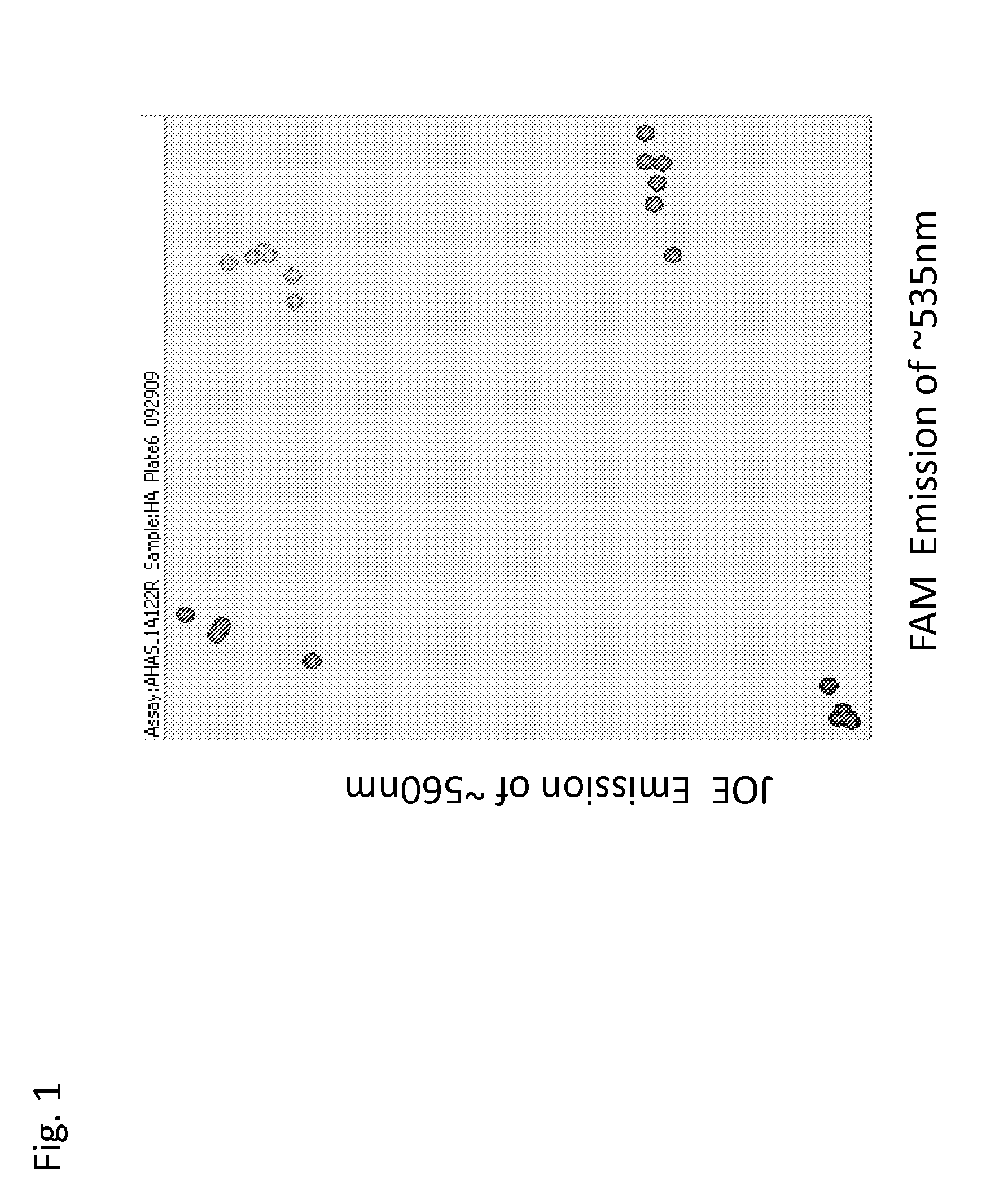High throughput single nucleotide polymorphism assay
a single nucleotide polymorphism and assay technology, applied in the field of high throughput single nucleotide polymorphism assay, can solve the problems of low throughput, inconvenient, time-consuming, and high cost of existing assays used to detect the haahasl1-a122(at)t specific mutation, so as to increase the efficiency of breeding selection and reduce cost and time.
- Summary
- Abstract
- Description
- Claims
- Application Information
AI Technical Summary
Benefits of technology
Problems solved by technology
Method used
Image
Examples
example 1
DNA Extraction and Quantification
[0064]Plants from a sunflower line which were previously characterized as homozygous for the HaAHASL1-A122(At)T mutant allele were used to develop a method to detect the HaAHASL1-A122(At)T mutant allele. In addition, a second sunflower line which was previously characterized as homozygous for the HaAHASL1 wildtype allele was used to develop a method to detect the HaAHASL1 wildtype allele. Resultantly, an HaAHASL1 method consisting of a homogeneous assay detection system for a PCR process using FRET to detect and distinguish the mutant and wildtype alleles was developed. After the HaAHASL1 method consisting of a homogeneous assay detection system for a PCR process using FRET was developed, it was validated using sunflower lines that had been previously genotyped.
[0065]Genomic DNA was extracted from leaf tissue of the sunflower line homozygous for the HaAHASL1-A122(At)T mutant allele and the sunflower line homozygous for the HaAHASL1 wildtype allele us...
example 2
Primer Design
[0066]Three primers (Table 1) were manually designed based on the nucleotide sequence information for the HaAHASL1 (SEQ ID NO:1) and the HaAHASL1-A122(At)T mutant allele (SEQ ID NO:2).
[0067]Mutant allele detection common primer 043-0001.1.A1 (SEQ ID NO:3) containing a tail on the 5′ end that is sequence identical to a KBiosciences reaction kit fluorescent-labeled primer was synthesized. The KBiosciences reaction kit fluorescent-labeled primer is labeled with the fluorescent dye, 5-carboxyfluorescein (FAM). This primer was specifically designed to amplify the HaAHASL1-A122(At)T mutant allele.
[0068]Wildtype allele detection common primer 043-0001.2.A2 (SEQ ID NO:4), containing a tail on the 5′ end that is identical to a KBiosciences reaction kit fluorescent-labeled primer was synthesized. The KBiosciences reaction kit fluorescent-labeled primer is labeled with the fluorescent dye, 2′,7′-dimethoxy-4′,5′-dichloro-6-carboxyfluorescein (JOE). This primer was designed to speci...
example 3
HaAHASL1 Single Nucleotide Polymorphism Assay
[0071]The three HaAHASL1 common primers were mixed to achieve the concentrations described in Table 2. The HaAHASL1 reaction cocktail and thermocycling program are described in Tables 3 and 4, respectively. HaAHASL1 PCR reactions were performed in 96-well plate format on a GENEAMP® PCR System 9700 (Applied Biosystems, Carlsbad, Calif.). HaAHASL1 PCR reaction product results were read on a fluorescence plate reader using the following parameters: (1) FAM: excitation at ˜485 nm and emission at ˜535 nm; and (2) JOE: excitation at ˜525 nm and emission at ˜560 nm. Fluorescence reading data were saved in Microsoft Excel format and the data were plotted on an x-y axis. The FAM values were plotted on the X-axis and the JOE values on the Y-axis.
[0072]The results of the assay are presented in FIG. 1. The samples known to be homozygous for the HaAHASL1 wildtype allele clustered to the top left of the graph. The sunflower samples known to be homozygo...
PUM
| Property | Measurement | Unit |
|---|---|---|
| fluorescent | aaaaa | aaaaa |
| fluorescent- | aaaaa | aaaaa |
| fluorescence ratios | aaaaa | aaaaa |
Abstract
Description
Claims
Application Information
 Login to view more
Login to view more - R&D Engineer
- R&D Manager
- IP Professional
- Industry Leading Data Capabilities
- Powerful AI technology
- Patent DNA Extraction
Browse by: Latest US Patents, China's latest patents, Technical Efficacy Thesaurus, Application Domain, Technology Topic.
© 2024 PatSnap. All rights reserved.Legal|Privacy policy|Modern Slavery Act Transparency Statement|Sitemap

